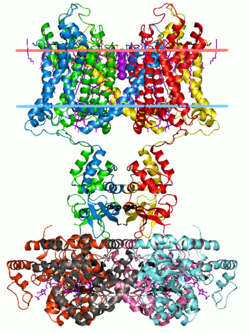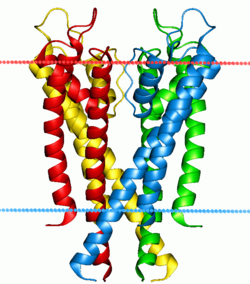Cation channel superfamily
Family of ion channel proteins From Wikipedia, the free encyclopedia
The transmembrane cation channel superfamily was defined in InterPro and Pfam as the family of tetrameric ion channels. These include the sodium, potassium,[1] calcium, ryanodine receptor, HCN, CNG, CatSper, and TRP channels. This large group of ion channels apparently includes families 1.A.1, 1.A.2, 1.A.3, and 1.A.4 of the TCDB transporter classification.
| Ion channel (eukaryotic) | |||||||||||
|---|---|---|---|---|---|---|---|---|---|---|---|
 Potassium channel Kv1.2 (with beta2 auxiliary subunits), structure in a membrane-like environment. Calculated hydrocarbon boundaries of the lipid bilayer are indicated by red and blue dots. | |||||||||||
| Identifiers | |||||||||||
| Symbol | Ion_trans | ||||||||||
| Pfam | PF00520 | ||||||||||
| InterPro | IPR005821 | ||||||||||
| SCOP2 | 1bl8 / SCOPe / SUPFAM | ||||||||||
| TCDB | 1.A.1 | ||||||||||
| OPM superfamily | 8 | ||||||||||
| OPM protein | 2a79 | ||||||||||
| |||||||||||
| Ion channel (bacterial) | |||||||||||
|---|---|---|---|---|---|---|---|---|---|---|---|
 Potassium channel KcsA. Calculated hydrocarbon boundaries of the lipid bilayer are indicated by red and blue dots. | |||||||||||
| Identifiers | |||||||||||
| Symbol | Ion_trans_2 | ||||||||||
| Pfam | PF07885 | ||||||||||
| InterPro | IPR013099 | ||||||||||
| SCOP2 | 1bl8 / SCOPe / SUPFAM | ||||||||||
| OPM protein | 1r3j | ||||||||||
| |||||||||||
They are described as minimally having two transmembrane helices flanking a loop which determines the ion selectivity of the channel pore. Many eukaryotic channels have four additional transmembrane helices (TM) (Pfam PF00520), related to or vestigial of voltage gating. The proteins with only two transmembrane helices (Pfam PF07885) are most commonly found in bacteria. This also includes the 2-TM inward-rectifier potassium channels (Pfam PF01007) found primarily in eukaryotes. There are commonly additional regulatory domains which serve to regulate ion conduction and channel gating. The pores may also be homotetramers or heterotetramers; where heterotetramers may be encoded as distinct genes or as multiple pore domains within a single polypeptide. The HVCN1 and Putative tyrosine-protein phosphatase proteins do not contain an expected ion conduction pore domain, but rather have homology only to the voltage sensor domain of voltage gated ion channels.
Human channels with 6 TM helices
Cation
Transient receptor potential
Canonical
Melastatin
Vanilloid
Mucolipin
Ankyrin
TRPP
- PKD1L3;
Calcium
Voltage-dependent
Sperm
Ryanodine receptor
Potassium
Voltage-gated potassium
Delayed rectifier
- Kvα1.x - Shaker-related: Kv1.1 (KCNA1), Kv1.2 (KCNA2), Kv1.3 (KCNA3), Kv1.5 (KCNA5), Kv1.6 (KCNA6), Kv1.7 (KCNA7), Kv1.8 (KCNA10)
- Kvα2.x - Shab-related: Kv2.1 (KCNB1), Kv2.2 (KCNB2)
- Kvα3.x - Shaw-related: Kv3.1 (KCNC1), Kv3.2 (KCNC2)
- Kvα7.x: Kv7.1 (KCNQ1) - KvLQT1, Kv7.2 (KCNQ2), Kv7.3 (KCNQ3), Kv7.4 (KCNQ4), Kv7.5 (KCNQ5)
- Kvα10.x: Kv10.1 (KCNH1)
A-type potassium
Outward-rectifying
- Kvα10.x: Kv10.2 (KCNH5)
Inwardly-rectifying
- Kvα11.x - ether-a-go-go potassium channels: Kv11.1 (KCNH2) - hERG, Kv11.2 (KCNH6), Kv11.3 (KCNH7)
Slowly activating
Modifier/silencer
Calcium-activated
BK
SK
IK
Other subfamilies
Inward-rectifier potassium
Sodium
Cyclic nucleotide-gated
Proton
Related proteins
- TPTE, part of the larger Voltage sensitive phosphatase family
Human channels with 2 TM helices in each subunit
Potassium
Tandem pore domain potassium channel
Non-human channels
Two-pore
Pore-only potassium
Ligand-gated potassium
- GluR0[2]
Voltage-gated potassium
- KvAP[3]
Prokaryotic KCa
Voltage and cyclic nucleotide gated potassium
- MlotiK1[16]
Sodium
Non-selective
- NaK[22]
Prokaryotic inward-rectifier potassium
- KirBac[23]
Engineered
References
External links
Wikiwand - on
Seamless Wikipedia browsing. On steroids.
